The Museum of Contemporary Art and California Plaza Are 2 Blocks South Down Grand
SAN DIEGO —
In 2018, dozens of critics and scholars signed an open letter to the Museum of Contemporary Art San Diego condemning a proposed renovation and expansion of its La Jolla building past New York-based Selldorf Architects, describing information technology equally "a tremendous fault." Four years out, that renovation and expansion is complete.
The brusque of it: The critics were incorrect.
The redesign, led by the house'due south founder, Annabelle Selldorf, has gracefully unified a jumble of buildings from diverse eras, added xxx,000 square feet of gallery infinite and reoriented the entire structure to the stunning feature it had long turned its dorsum on: the Pacific Ocean.

The Sahm Seaview Room and Bartell Terrace with views of the Pacific at the Museum of Gimmicky Fine art San Diego in La Jolla.
(Studio MAHA)
On the northern finish of the property, a new public art park boasts terrific views of the h2o. It'southward an infinitely ameliorate use of the space than what was there prior to the renovation — MCASD's parking lot and a dumpster. It had to be the most extravagant dumpster real estate in all of California.
The museum, which reopened to the public on April 9, now has a more prominent archway, improved circulation routes and greater accessibility — including a wheelchair lift on the western side of the building, which can draw a company straight upwards to the terrace areas rather than requiring a zigzag journey upwards a very steep course.
Information technology has also made critical improvements to dorsum-of-house functions. In the onetime structure, for case, the freight elevator opened right into the middle of a gallery, which meant that, for artful purposes, drywall was frequently used to hide the infrastructure. Getting art into and out of the building required — quite literally — ripping out walls. Now the freight elevator leads to a transition space between galleries and is protected by a big panel that can exist easily opened and closed.
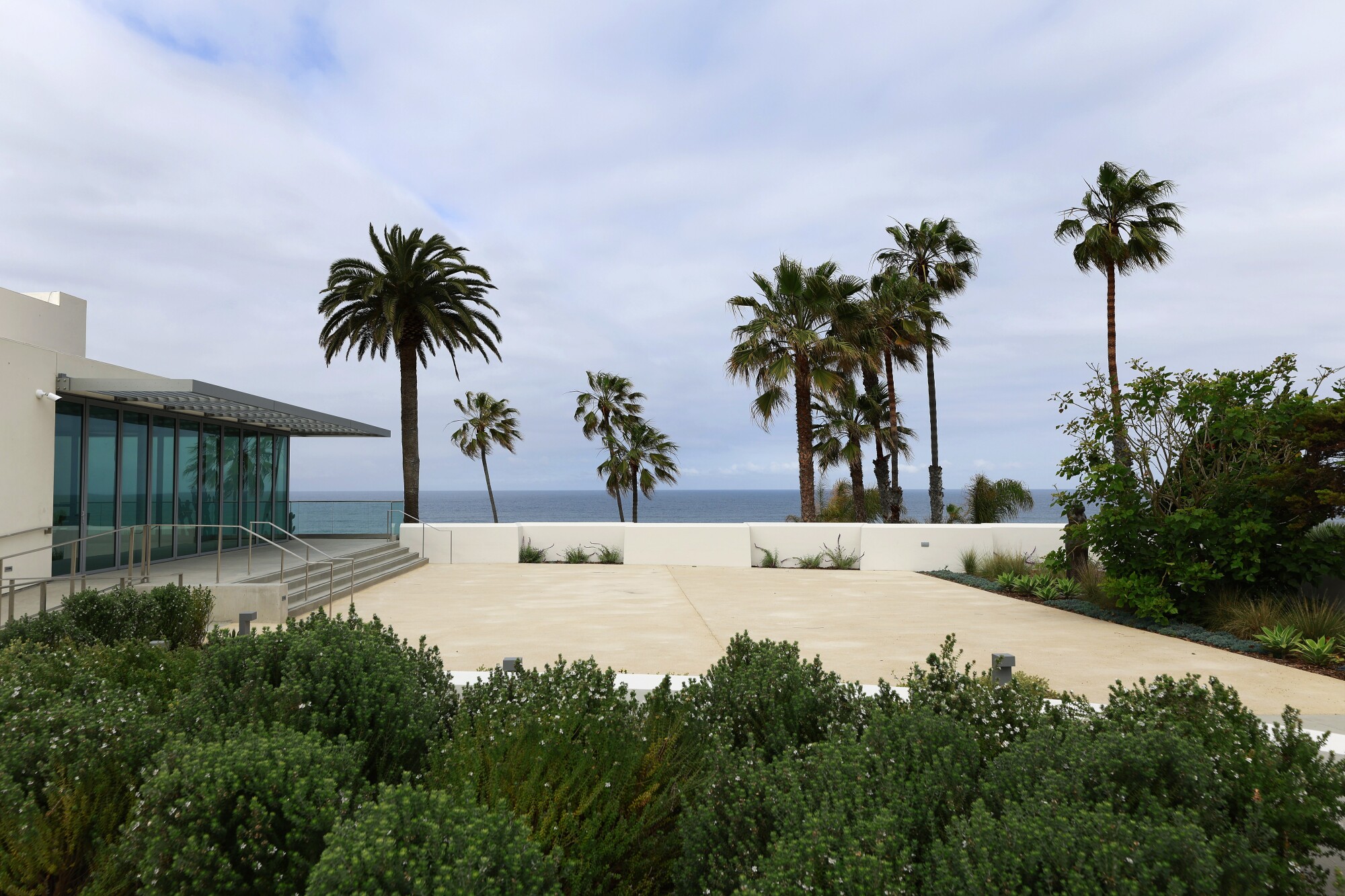
One time a parking lot and dumpster surface area, MCASD's new fine art park is a public space with bounding main views.
(K.C. Alfred / The San Diego Union-Tribune)
Information technology's been a long road to go there.
MCASD'due south accretion of buildings began life as a residence designed and built by early Modernist Irving Gill for philanthropist Ellen Browning Scripps, completed in 1916. By the 1940s, that building had been converted into an art center, and as its needs grew, so did the architecture. In 1950 and 1960, expansions past San Diego house Mosher Drew added gallery space around the residence, too every bit a theater.
Another expansion in 1996 past Venturi, Scott Brown and Associates, the Philadelphia firm founded by famed postmodernist Robert Venturi and his partner Denise Scott Chocolate-brown, removed portions of the Mosher Drew blueprint and rebuilt Gill'southward svelte facade — including a lovely, arched sun porch — which they framed with pergolas of bold Doric columns. The additions too included a buffet, a iii-acre sculpture garden with ocean views and a new entrance: Axline Court, a star-shaped atrium that features a series of decorative fins that descend from the ceiling and are bordered in neon lite.
The atrium brought a splash of postmodern drama to an otherwise low-key structure.

MCASD'south flamboyant Axline Court was designed by Venturi, Scott Brown and Associates in the 1990s. Information technology was retained in the recent renovation past Selldorf Architects.
(K.C. Alfred / The San Diego Matrimony-Tribune)
By 2014, all the same, MCASD was prepare to expand yet again since the museum had no dedicated infinite for its permanent drove.
Selldorf's program reimagined the theater equally a double-height gallery infinite and extended the museum's exhibition areas into an adjacent property that had been caused by the museum roughly a decade earlier. Just controversy emerged with the plan to relocate the chief entrance to the new fly and remove the pergolas that had been added to the circuitous by Venturi, Scott Brown (now known as VSBA). Among other things, the open letter alleged that the moves would turn Axline Court into an "empty atrium" and that relocating the archway to the southward was "a slap in the face to Gill."
Neither of those eventualities has come to pass.
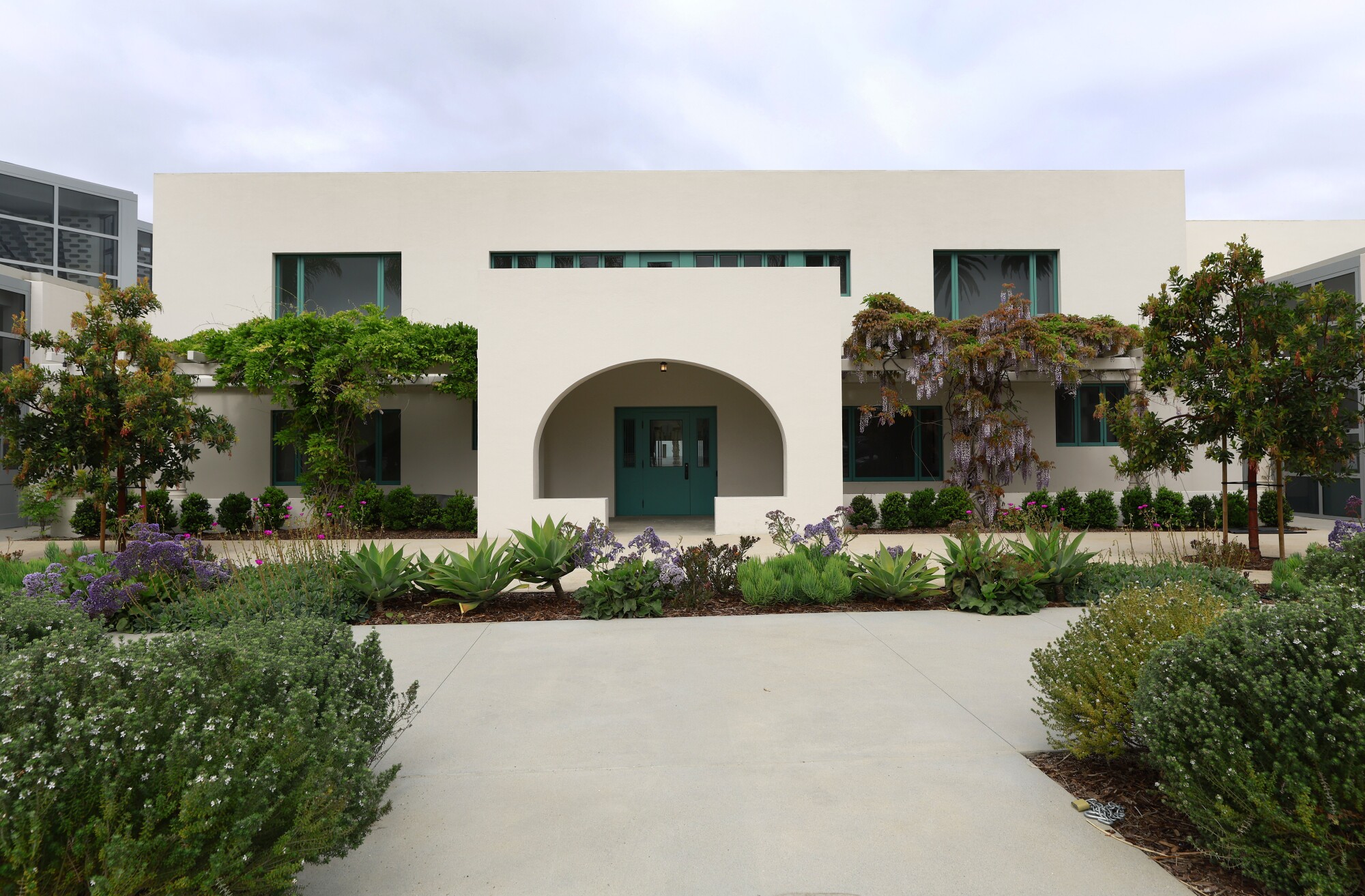
The facade of a residence designed by Irving Gill — post-renovation — emerges from the greater MCASD edifice.
(Thou.C. Alfred / The San Diego Union-Tribune)
Axline Court remains its exuberant postmodern self and still functions as a critical juncture. For one, information technology is a vital betoken of connexion between the museum's northern and southern wings — and interestingly, currently the site of an installation of works by artists from San Diego and Tijuana. It as well serves equally a free public gallery and point of admission to the ocean-view terraces and sculpture garden on the western side of the building — no admission necessary. At night, the atrium's neon lantern remains visible from the street.
And the Gill facade? It pops.
In fact, it'south hard to imagine that it might exist overlooked next to the buffet and the new ocean-view art park. Moreover, judicious plantings around the construction prevent it from being overwhelmed by the scale of what is now the museum's longer, albeit withal low-slung, facade. Removing the Venturi, Scott Brown pergolas has made Gill'due south blueprint more visible than ever. And these structures oasis't completely disappeared from San Diego; 1 of them can at present be found right up the block in the garden of the La Jolla Historical Club.
Ultimately, Selldorf and her team have found a way of elegantly knitting together all of the spaces from the various celebrated eras merely also allowing each of these eras to shine through. To walk along Prospect Street and Coast Boulevard, the two thoroughfares from which MCASD is well-nigh visible, is to continue a tour of 20th century architectural history: Gill'southward intimately scaled early Mod work, Mosher Drew's Midcentury boxes and Venturi, Scott Brownish'southward biconvex facades — which were inspired by Gill's architecture (such as the La Jolla Woman's Society, located across the street). To this, Selldorf added her own vocabulary in the new fly: uncomplicated board-formed physical volumes clad with travertine, which give the new edifice a sedimentary feel — a visual nod to the coastal cliffs on which the museum resides.
One of the principal charges of the renovation, says MCASD Director Kathryn Kanjo, "was to give us more infinite and be mindful of who we are, of our history, and opening information technology up."

MCASD's new fly, equally seen from Coast Boulevard, was designed by Selldorf Architects and adds new idioms to the museum's architecturally eclectic campus.
(One thousand.C. Alfred / The San Diego Wedlock-Tribune)
The $105-meg renovation was led by Selldorf, with a team of designers and architects from her 70-person New York City part, including Sara Lopergolo, Wanda Willmore, Ryoji Karube and Corey Crist. The San Diego-based LPA Inc. served equally executive architects.
San Diego's second museum redesign: The Mingei
The MCASD project is one of two contempo museum revamps in San Diego that stand out for their surgical dexterity and aesthetic restraint. A $55-1000000 renovation and expansion of the Mingei International Museum by LUCE et studio, a 6-person San Diego house founded by Jennifer Luce, has added 10,000 square feet of space to the well-nigh 4-decade-old craft and design institution housed in Balboa Park. And information technology's helped transform the museum'due south relationship to the public spaces around it.
The makeover reimagines a construction that could have been trapped in historic amber had the architect or the museum'southward leadership, led by CEO and Executive Director Rob Sidner, been less ambitious.
The House of Charm, as the edifice that houses the Mingei is more formally known, was designed by Carleton Winslow under the direction of supervising architect Bertram Goodhue (the creator of L.A.'s Central Library) for the 1915-16 Panama-California Exposition. Similar many structures in the park, it draws from a mix of colonial architectural styles, including Mission Revival and Spanish churrigueresque — much of information technology inspired by Mexican religious architecture of the colonial era. (Balboa Park is a veritable fetish feast of all things Castilian colonial.)
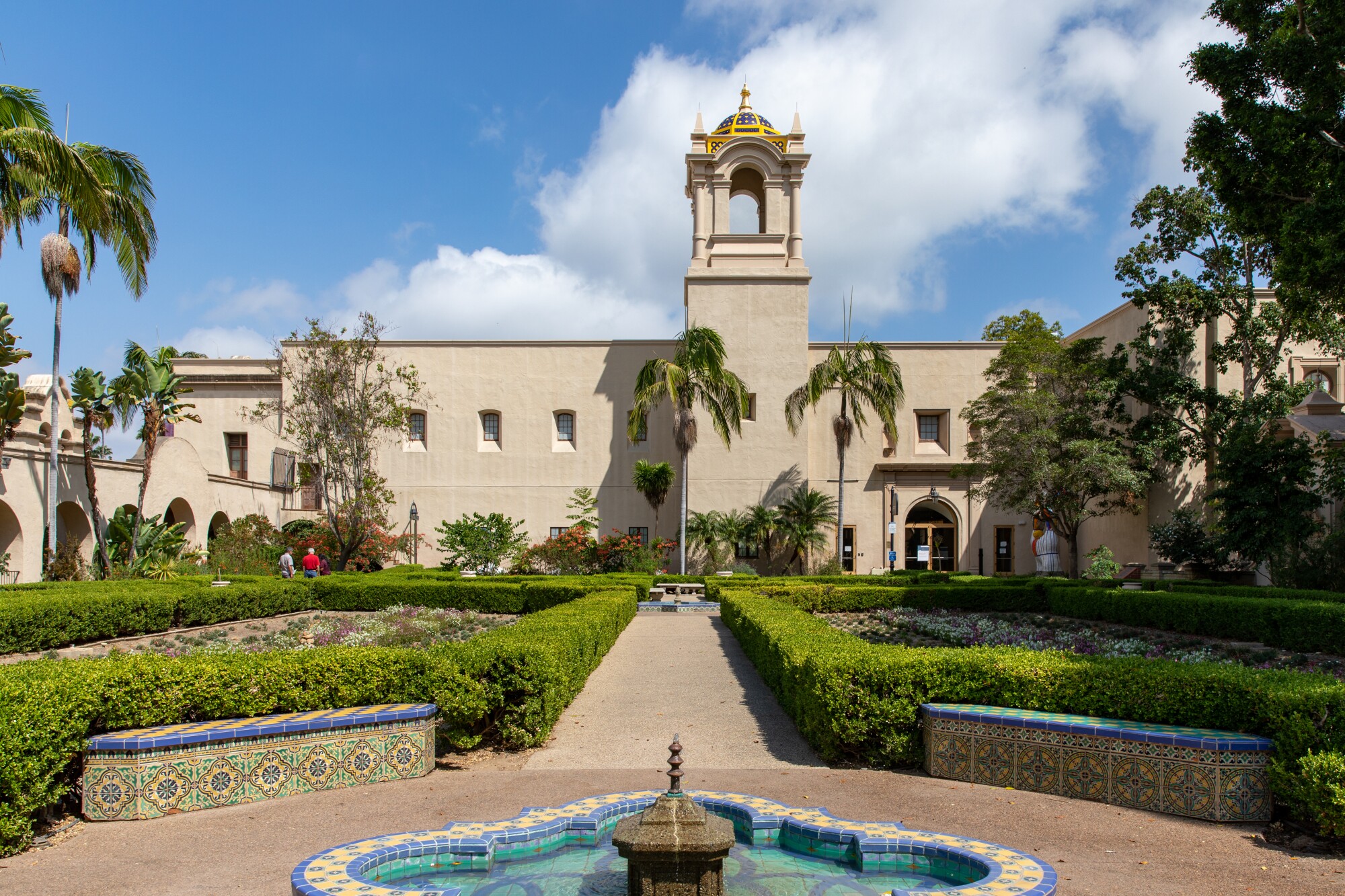
A redesign of the Mingei Internataional Musem by LUCE et studio embraces the Alcazar Garden in Balboa Park.
(Mingei International Museum)
But the building was intended more equally showpiece than equally habitable structure. "Like many exposition buildings, these buildings are merely nearly the facade and how they make space inside the landscape," says Luce. "The interior was just a box."
Nor were they designed for the long haul. In the 1990s, the House of Charm was torn down and rebuilt due to structural problems — making it a historic structure that is ersatz in nature, not to mention several levels of meta: a historic structure that is a reconstruction of a historic structure that was itself a copy of celebrated designs from Mexico.
Luce and her squad — which included Ann Worth, Kei Tsukamoto and Lori Krause — began with the basis floor: reimagining a infinite that in its previous incarnation had been architecturally closed off from the street, with niggling access to daylight, its prime point of entry obscured by a wall of vegetation and an arched esplanade.
Previously, visitors to the building would take been greeted by a reception desk and an elevator bank, followed by a warren of exhibition areas. The architects have now reimagined this space as a wide-open public commons that visitors tin traverse without having to pay admission. The surface area now buzzes with activity.

The redesign of the Mingei more effectively connects the museum with the outdoors — as demonstrated by the new theater, which can be converted into an indoor/outdoor amphitheater.
(Mingei International Museum)
Blind arches were punched out to make way for windows. A new entry was added on the western side of the building, which now allows a direct point of admission to the Alcazar Garden, a lovely formal garden inspired by the landscapes at Seville's famed Moorish palace, the Real Alcázar.
The architects then consolidated the Mingei's gallery functions on the second floor, which opened up the lobby to a new contemporary restaurant (Artifact), a coffee counter (Craft), a gift shop and a stepped public seating area where you lot tin can simply accept a seat and relax. Around the anteroom, vitrines and wall hangings characteristic works from the permanent collection — including an exquisite (and functional) cherrywood bench by celebrated woodworker George Nakashima — thereby functioning as a complimentary public art infinite.
Luce, in collaboration with metals fabricator A. Zahner Co., likewise designed a ceiling canopy for the vestibule, titled "Suspended Refrain," which harkens to the geometric patterns of player piano rolls. Made of die-cutting stainless steel, the pattern renders the thespian piano roll for the late-'60s jazz standard "What Are You lot Doing the Rest of Your Life?" that was popularized by Barbra Streisand. Information technology's a sleek scrap of blueprint that updates the museum'southward aesthetics while nevertheless harkening to vintage craft.
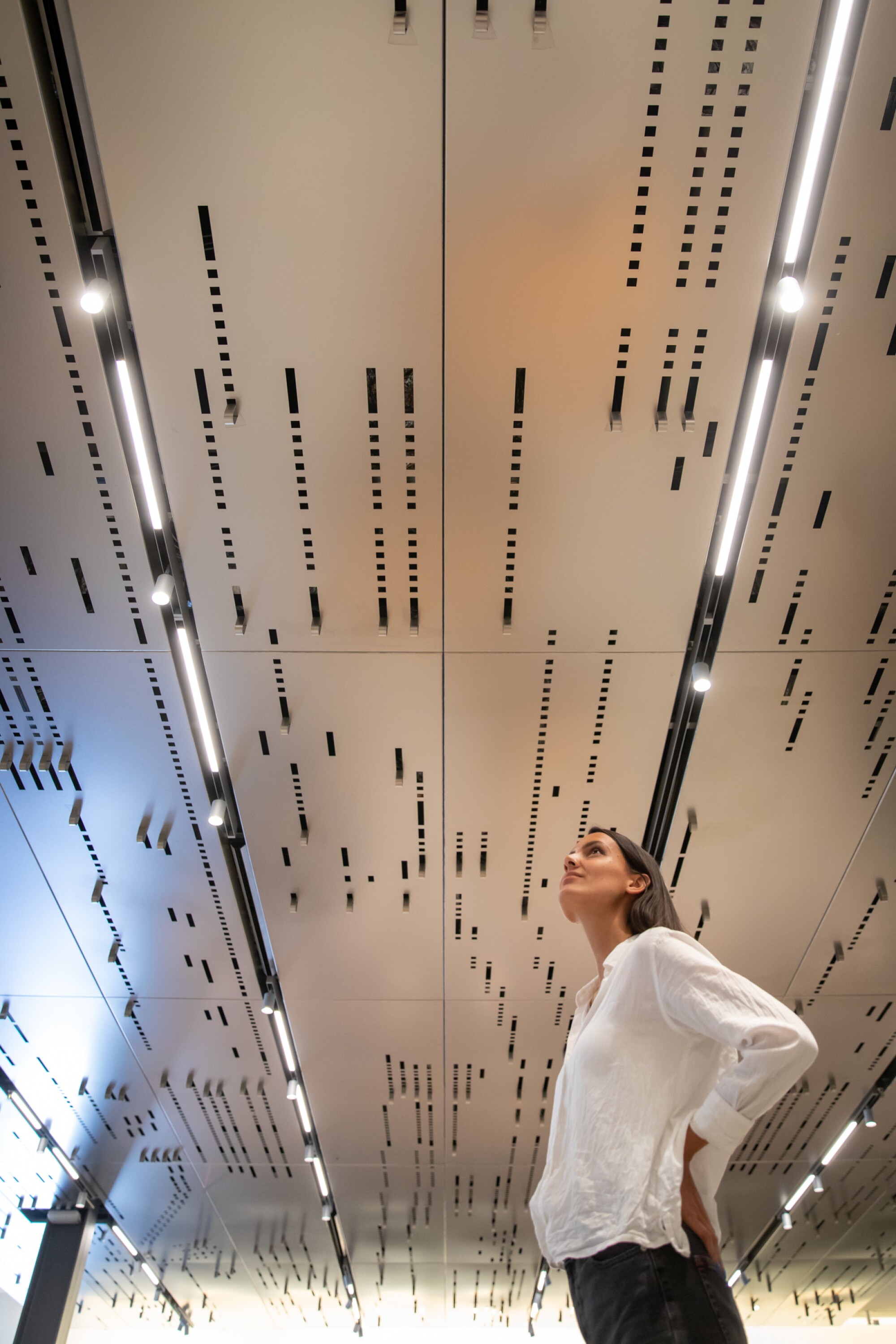
"Suspended Refrain" is a 125-human foot-long stainless steel ceiling canopy inspired by player piano rolls. It was designed by Jennifer Luce with metals fabricator A. Zahner Co.
(Mingei International Museum)
Some of the almost dramatic improvements are the ways in which Luce and her team have deftly reimagined existing spaces. A loading dock on the edifice's southern stop, which had long lay unused due to its steep grade and awkward angle, was reimagined as a small, ground-floor theater infinite with a pleasant outdoor patio on top. (The patio connects to the eating house at foyer level.)
On the 2d story, a series of terraces, which had long been blocked off, were rehabilitated — and now provide postcard views of Balboa Park.
The Frances Hamilton White Fine art Library, a reference space, had been hidden away at ground level. Now it has been reimagined equally a lite-soaked report space on the 2nd floor — complete with a walnut and hickory study table designed past Nakashima and Vitsoe 606 modular shelves developed by German industrial designer Dieter Rams (a system so notable information technology resides in the permanent collection of New York's Museum of Modernistic Fine art). For design bibliophiles, it is a fantasy space.
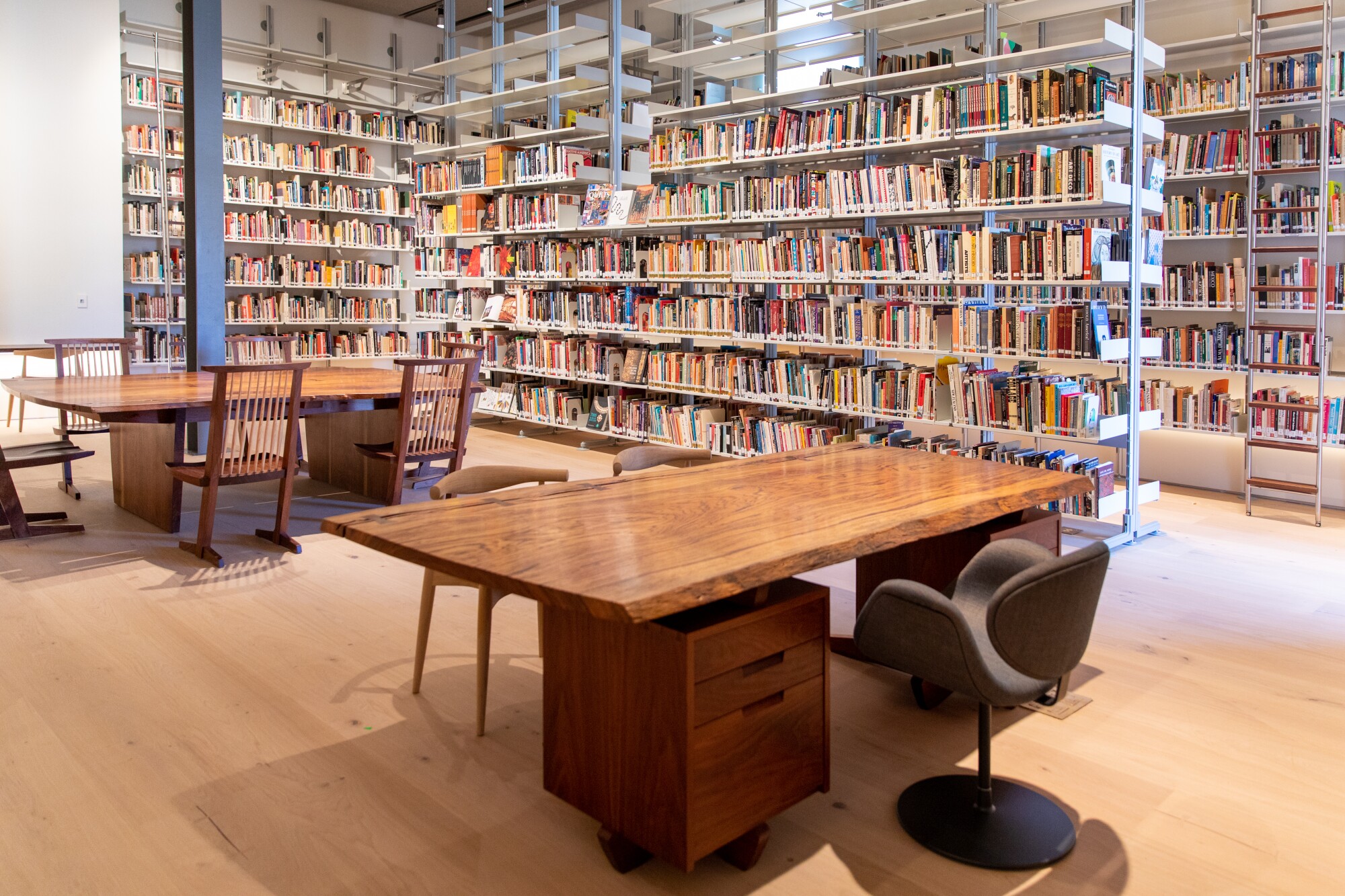
LUCE et studio's redesign has imagined many of the museum's spaces — such equally the reference library, which had in one case been tucked away on the ground flooring.
(Mingei International Museum)
Ane of the more than remarkable touches is the new staircase.
Though the edifice has a tower, it had been unused. As part of the renovation, the architects carved into it, inserting a staircase into its shaft. Merely rather than leave the shaft as a manifestly rectangular prism, Luce and her team created a series of subtle, origami-like folds in the walls around the stairs, which are capped at the top by a skylight. Throughout the mean solar day, the sun plays on these forms and on the Dale Chihuly chandelier suspended in the space.
(I could practice without the Chihuly, simply the museum is then well designed, I'll give it a pass.)
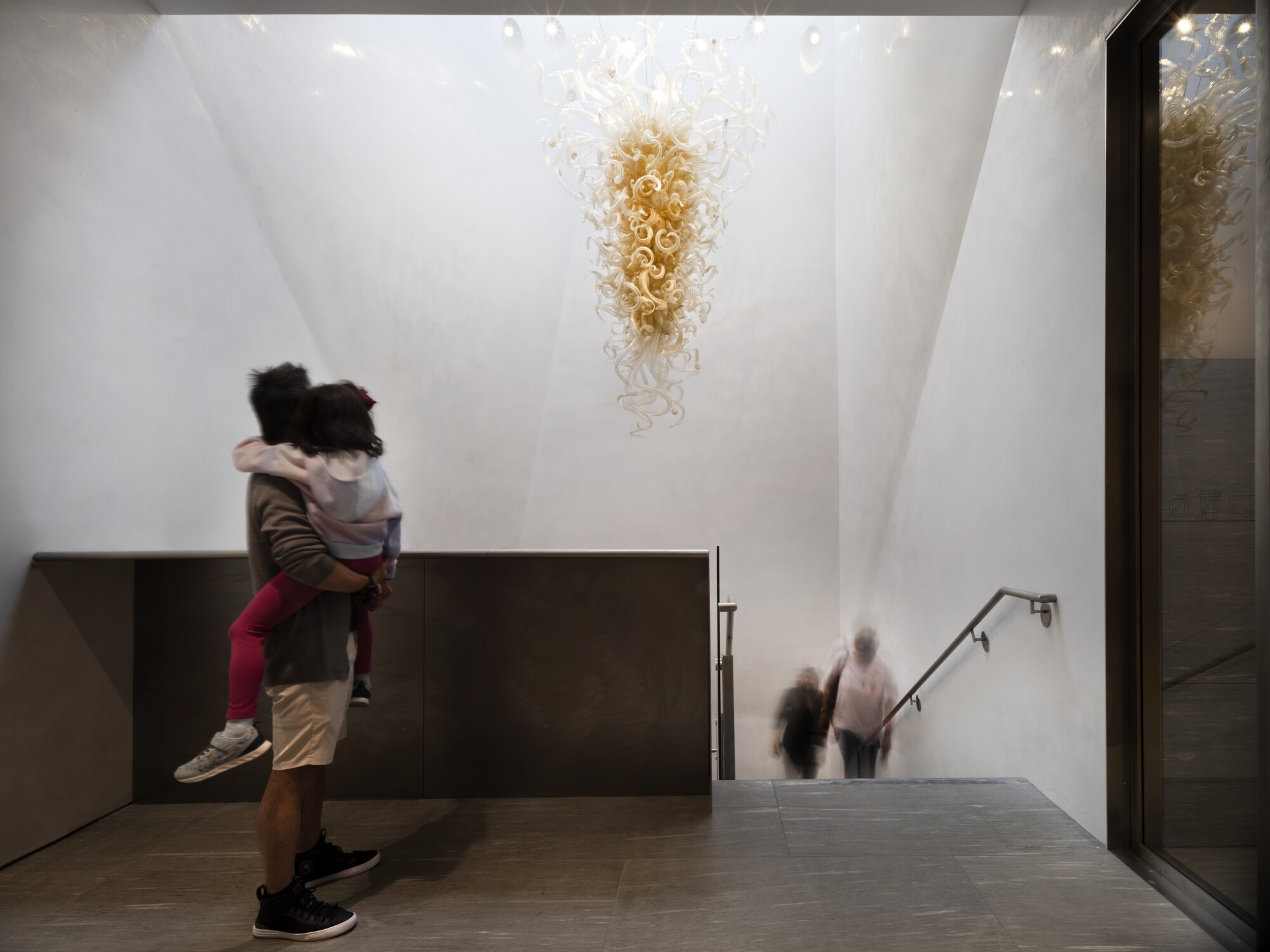
The redesign of the Mingei has carved a new staircase into what was one time an unused tower — with a design that evokes origami.
(Nic Lehoux)
Challenges lead to innovation
The renovations of MCASD and the Mingei are very different projects at very different scales, simply they share certain qualities: difficult sites (both sit on steep lots with grades that drop by at least a story), historic compages that needed to be upgraded for the 21st century, even as primal aspects needed to be preserved, and the conversion of insular structures into ones that better appoint the Southern California environment.
Both projects, in fact, are thoughtful well-nigh the ways in which they integrate fresh air and the outdoors into the museum experience, rather than simply encasing visitors in vast tombs of HVAC. At the Mingei, the new basis floor theater tin can exist transformed into an indoor/outdoor amphitheater with the retraction of a 40-human foot glass wall. At MCASD, there is the Sahm Seaview Room, in which Selldorf Architects took what was once the buffet's loading dock and transformed it into a glass-walled upshot space that tin be fully opened to connect with the outdoor art park.
These design moves, conceived prior to the pandemic, now experience incredibly prescient.
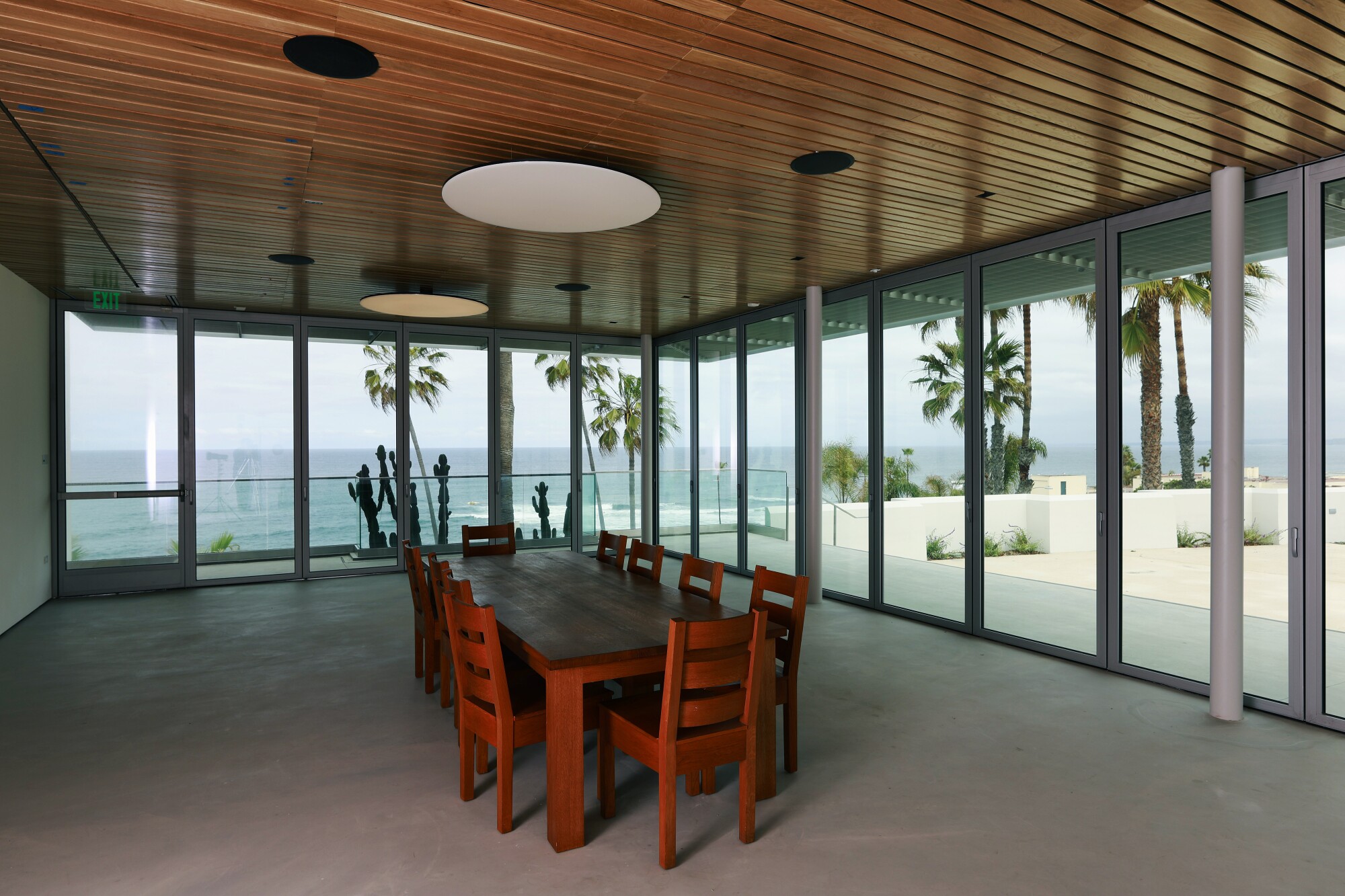
The drinking glass doors in the Sahm Seaview Room at MCASD tin be fully opened to the outdoors to admit fresh air, and besides connect the space with the adjacent art park.
(G.C. Alfred / The San Diego Marriage-Tribune)
The niceties don't come up at the expense of the museum experience.
At MCASD, a museum that previously had a slightly confused circulation route, I was struck past Selldorf'southward thoughtful sightlines, the means in which the dimensions of the spaces vary to adjust works of different scales, the shifting amounts of daylight that penetrate the different galleries, the windows that frame trees and slivers of ocean, the doorways that offer portals from the compages of i era into another.
Selldorf is no stranger to museum architecture — nor is she a stranger to rethinking preexisting museums. She has led redesigns and updates of the Neue Galerie in New York and the Clark Fine art Institute in western Massachusetts. In 2018, she and her team helped design a reinstallation of the permanent collection at the High Museum in Atlanta.
In 2016, when Selldorf was still in the process of conceiving MCASD'southward design, I asked her what it was similar to reimagine a campus that contained works by so many notable architects. "Yous do it with a trembling hand," she told me. "And you try to practise everybody justice."
Her paw did not tremble. And MCASD is a ameliorate experience for it.
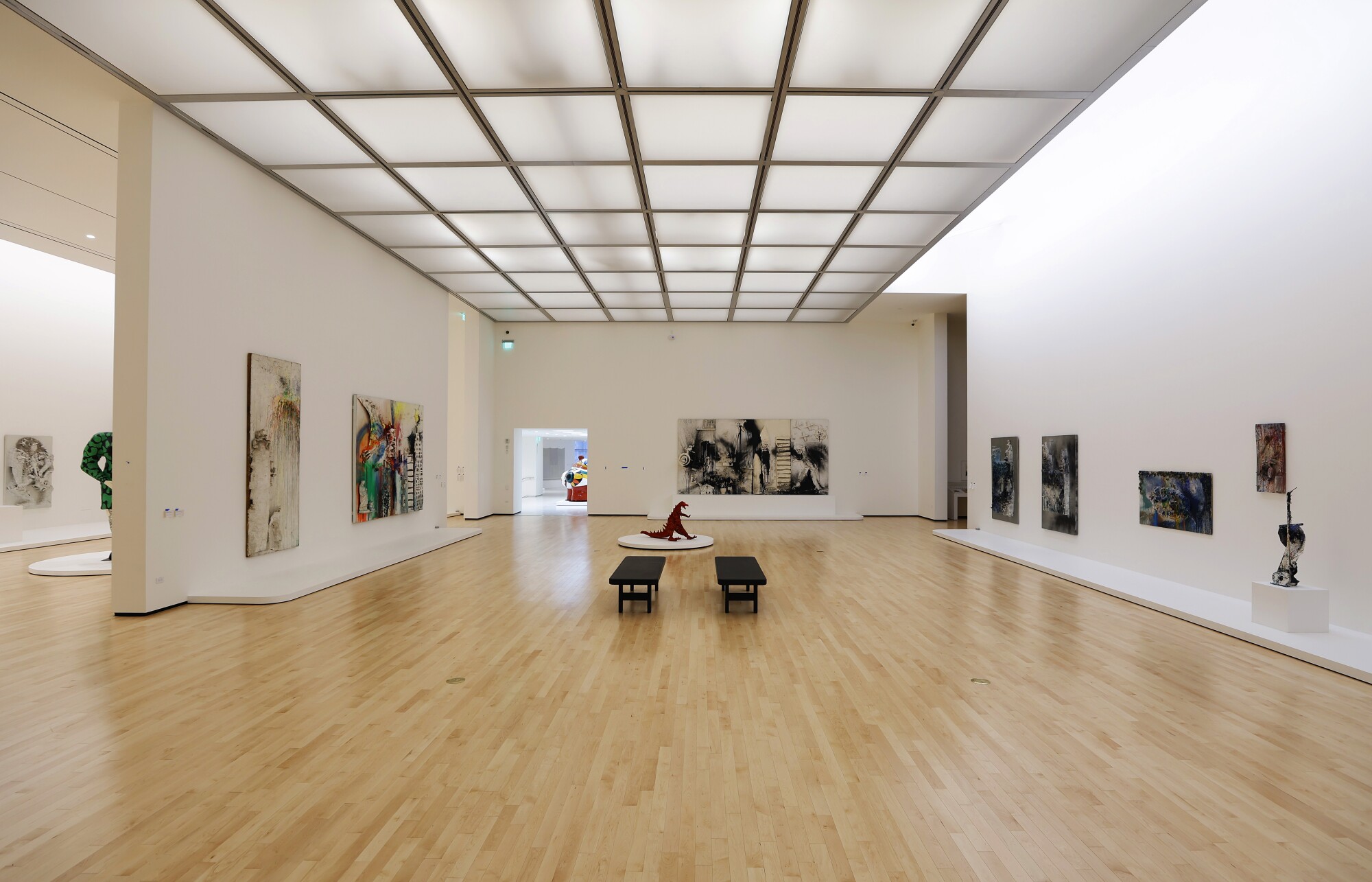
A view of one of new galleries in the Selldorf-designed wing of the Museum of Contemporary Art San Diego.
(M.C. Alfred / The San Diego Wedlock-Tribune)
macdonellfludersomand63.blogspot.com
Source: https://www.latimes.com/entertainment-arts/story/2022-04-12/museum-of-contemporary-art-and-mingei-museums-get-needed-updates